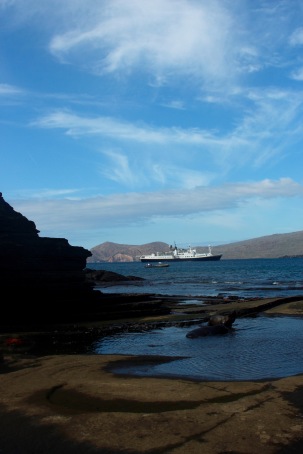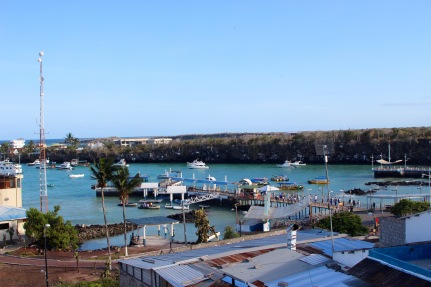Thursday, September 24th- 23:55

Life has been full aboard (and off board) the Endeavor…so busy in fact that it has been difficult to find the time to write. From the young volcanic islands of Fernandina and Isabella we have sailed east to Santiago then on to the island of Santa Cruz. We have left the cold waters, which paradoxically, and amazingly, are shared by penguins and green sea turtles, and we are now back into warmer seas. Days have been spent exploring the islands immersed in conversations with naturalists, embarking on deep-sea snorkeling excursions to better understand the marine ecology, and collaborating with the other NG Grosvenor Teacher Fellow (Mike Presser) on a very exciting digital story telling project we’ve come up with using the spherical video camera, the Ricoh Theta in tandem with Google mapping software to share our lessons from the Galapagos with our classes and the world. Stay tuned to see what becomes of this:)
There is a growing list of topics, themes, ideas, relationships etc. that I’ve been mulling over and processing –all as new experiences and information are shuffled into the mix. Many of these morsels will hopefully get a little more digesting and will, at some point, find their way here. In the meantime, there was a piece of writing that I just put together with Mike as one of our fellowship contributions to the expedition that I wanted to share. Check out the Daily Expedition Report (DER) we wrote up for Thursday, September 25th. Check HERE for a link that has past DERs (dates 9/21-27)
| *Note: If you read my last blog post (from 9/22) with the picture of me on the equator were you able to identify what was so unique? Could you explain what causes this? Hint: Look at the shadows. Stay tuned on this, I’ve been working with the National Geographic video chronicler on a video clip about this, which I’ll post here. |
NG Endeavor Daily Expedition Report
Thursday, September 24th, 2015 Puerto Ayora, Santa Cruz Island
After plying eastward overnight from Santiago Island, we awoke this morning in Academy Bay offshore from Puerto Ayora on the Island of Santa Cruz. Following our days exploring the unpopulated environments of the Galapagos, the sights and sounds of ship engines, local music, shopkeepers, and Galapaguenos carrying on with their everyday lives struck a sharp contrast and led us to focus more closely upon the human story that has unfolded and continues to unfold here on the islands.
Our adventures began as our Zodiac cut through the morning light en route to Puerto Ayora. This is the research and tourism hub of the islands as well as home to a majority of Galapagos residents–including so many of the wonderful staff of the NG Endeavor. Once on dry land, we ventured to the Charles Darwin Research Station, an organization that has worked tirelessly advocating for conservation, combating the perilous spread of invasive species, and saving the iconic giant tortoises from the brink of extinction. A meandering cobblestone walk, a visit to the open-air fish market ringed with pelicans, iguanas and sea lions and a highlands-bound bus ride later we arrived at the Tomas de Berlanga School. As this expedition’s two Grosvenor Teacher Fellows, we had been happily anticipating the visit to this conservation-minded school sponsored and supported by Lindblad Expeditions. After a visit with the students and teachers, we left happily convinced that the spirit and ethos of conservation is alive and well in the next generation of Galapaguenos.
Fueled by a delicious lunch from the local restaurant, Aqualerre, we struck out through the welcome lush of the highlands into the land of the tortoise. We found these giant reptiles by the dozen spread about in fields and forest like boulders, moving only slightly faster as they plodded along in their seasonal migration. You may hear of the Galapagos giant tortoises or you may watch them in documentaries, but nothing prepares you for the opportunity to lay belly-down in the pasture eye to eye with them as they eat grass, shift their grand bodies, eat some more grass, and remind you to slow down.



#linkripoff #linkoff
LikeLike